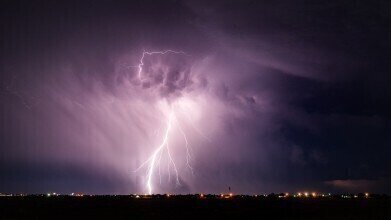News
First Picture of Thunder Snapped
May 26 2015
We’ve all seen epic photographs of lightning forks ripping down to earth but what about the thunder that follows?
Until now, the sonic shockwaves have remained unseen to the human eye. That is until a team of US scientists managed to capture a visual map of the resounding booms that follow the sudden expansion of air that occurs when lighting hits. According to the team, the map could uncover the mysteries behind the energies that power some of Mother Nature’s most spectacular light and sound shows!
New research allows us to hear and see thunderclaps
Lighting occurs when negatively charged clouds send an electric current shooting down to the ground. As the lighting fork gains heat the air around it expands which creates the powerful sonic shockwaves that we call thunder. Scientists have an in-depth understanding of what causes the sounds, however, until recently the actual physics behind the claps, crashes and rumbles has remained largely illusive. Not anymore! As part of the experiment, scientists at San Antonio’s Southwest Research Institute created their own lightning forks by propelling a string of Kevlar-coated copper wire into an electrically charged cloud. Heliophysicist, Maher Dayeh, was head researcher and used 15 sensitive microphones to capture sonic shockwaves occurring 95 metres away from the strike zone. Using the sound capturing equipment Dayeh and his team were able to put together an amazingly detailed acoustic map of the lightning strike.
Dayeh explained the process behind the project, saying “We created a ‘special ear’ that can amplify sounds coming from a specific direction” he added “this enabled us to collect and amplify sound signals coming from specific portions of the lightning channel.”
The resulting images were both beautiful and scientifically fascinating, showing purple acoustic sound waves colliding with the glowing green path carved by the lightning channel. Dayeh explains that the process is known as ‘beamforming,’ a technique that’s similar to the one sonographers use when using ultrasounds to capture images of infants in wombs. He stated: “This is the first time this technology has been applied to understand thunder and lightning.”
One of the key discoveries the project unearthed was the fact that the sound intensity of thunderclaps depends on how powerful the peak electric current that flows through the lightning rod is. According to Dayeh, this new intelligence could soon allow scientists to use thunder to determine the energy levels of individual lightning strikes. “This tells us more about the origins of thunder, which in turn allows us to better understand the energetic processes associated with lightning” explained Dayeh. “In this case, we may be able to learn more about the faster processes (lightning) by looking at the slower response (thunder). For instance, we can tell if the branches of lightning create acoustic signatures or not.”
He presented the results at an American Geophysical Union meeting, much to the fascination of attendees. Want to see the incredible project for yourself? Check out this video that shows the project unfold: http://ilmt.co/PL/xp2n
To read about more recent discoveries in science, technology and nature read: Introducing the Sichuan Bush Warbler – A New Species of Bird.
Digital Edition
Lab Asia Dec 2025
December 2025
Chromatography Articles- Cutting-edge sample preparation tools help laboratories to stay ahead of the curveMass Spectrometry & Spectroscopy Articles- Unlocking the complexity of metabolomics: Pushi...
View all digital editions
Events
Jan 21 2026 Tokyo, Japan
Jan 28 2026 Tokyo, Japan
Jan 29 2026 New Delhi, India
Feb 07 2026 Boston, MA, USA
Asia Pharma Expo/Asia Lab Expo
Feb 12 2026 Dhaka, Bangladesh



















